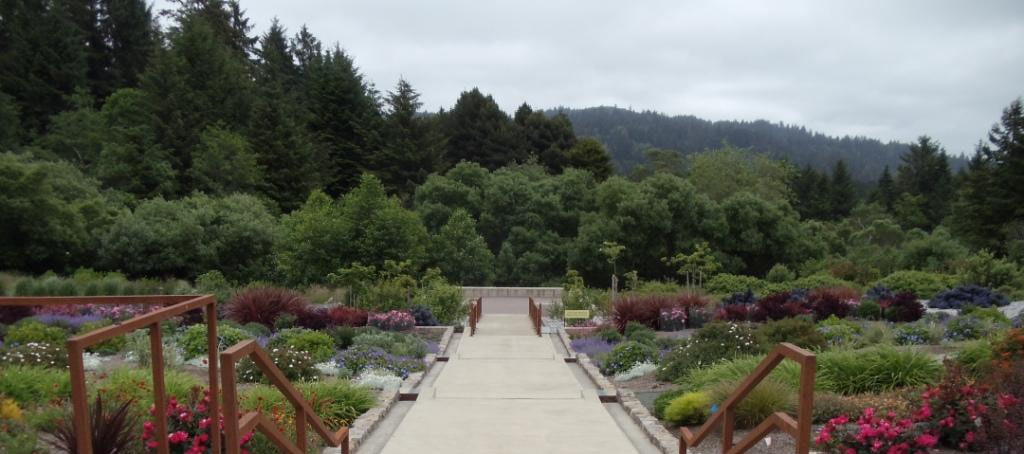
Humboldt Botanical Garden
Get Your Nature On
By Benjamin Fordham

Humboldt Botanical Garden
Get Your Nature On
As we hurry back and forth in our daily lives, it’s easy to mistake the rat race for reality. It’s not. Reality is plants and animals, the sun and sky. Reality is quiet, and peaceful. And if you’re in need of it, the Humboldt Botanical Garden is an excellent place to find it.
Turn off at the North Entrance to College of the Redwoods and you’ll find the Botanical Garden, located on the CR campus. The garden is a great place to spend a little quality time with our co-habitants on this planet, the plants. Slow down, walk around, and you will find yourself adjusting to their pace.
Open to the public since 2006 and maintained by the Humboldt Botanical Garden Foundation, this 44.5 acre garden contains numerous smaller, themed gardens and dirt or gravel trails to explore. If you go, plan on spending at least an hour, although you will probably want to stay longer. There are also picnic tables available, so you can make a day out of it if you like.
 Containing various micro-climates and special features, the gardens have something to offer for people of all ages and interests. Stroll through a rainbow spectrum of plants in the Dedekam Ornamental Terrace Garden, or check out the ADA-accessible Wildberries Natural Riparian Area. View the extensive rhododendron collection, or do some bird-watching.
Containing various micro-climates and special features, the gardens have something to offer for people of all ages and interests. Stroll through a rainbow spectrum of plants in the Dedekam Ornamental Terrace Garden, or check out the ADA-accessible Wildberries Natural Riparian Area. View the extensive rhododendron collection, or do some bird-watching.
You can even find, in the Moss Family Temperate Woodland Garden, a specimen of the ultra-rare Wollemia nobilis, or Wollemi Pine, thought to have gone extinct 120 million years ago. According to Collin Tudge in Secret Life of Trees, finding specimens of the Wollemi growing in Australia in 1994 was “conceptually similar” to finding a living T-Rex.
The garden also places an emphasis on native plants, offering a true glimpse into what natural Humboldt essentially is. In a world where all our cars and houses look the same, this is a chance to see what has grown in our area for more than 500 years.
You’ll find conifers, irises, lilies, lilacs and strawberries all native to the area. Native plants generally require less water, fertilizer, pesticides, and maintenance than non-natives. (For more on Native Gardening see “Native Gardening: You Can and You Should”)
There are also a number of classes and events offered at the gardens, ranging from corporate functions and fund-raisers to weddings and birthday parties. Classes are offered through the HBGF Educational Series, with classes upcoming on plant propagation and sustainable landscaping.
 Another nice feature of the gardens are the many eye-catching sculptures. Ranging from whimsical to elegant, you will find them placed strategically throughout the grounds as you explore. They add a pleasing, satori-inducing dimension to the experience. Seeing the sculptures here, out in nature, it really seems a perfect venue for them.
Another nice feature of the gardens are the many eye-catching sculptures. Ranging from whimsical to elegant, you will find them placed strategically throughout the grounds as you explore. They add a pleasing, satori-inducing dimension to the experience. Seeing the sculptures here, out in nature, it really seems a perfect venue for them.
At the back of the garden you will find Peter Santino’s “All Happy Now” earth sculpture. The sculpture consists of a 100-foot in diameter, gently rising earthen mound worked into a yin-yang symbol. Completed in 2008 and located on a bluff with fantastic views of the surrounding area, “All Happy Now” gives visitors the opportunity to sit and reflect, or interact. I personally recommend that you walk one of the circular paths to the top. Once there, lay down in the middle of the mound for at least 10 minutes. You will feel better.
If you’re fit and don’t smoke, I also highly recommend you make the climb to the Oliver Eitzen Lookout Point. This spot also features amazing views of the surrounding area, including Table Bluff, Humboldt Bay, and the Pacific Ocean. From here you realize that, in actuality, the freeway is just a tiny, thin strip of land in an otherwise vast wilderness.
 The Humboldt Botanical Garden is a member of the American Horticultural Society’s Reciprocal Admission Program, or RAP, which provides members with free or reduced prices to over 200 botanical gardens nationally.
The Humboldt Botanical Garden is a member of the American Horticultural Society’s Reciprocal Admission Program, or RAP, which provides members with free or reduced prices to over 200 botanical gardens nationally.



Leave a Reply